Weird Cat Behaviors Explained-
Why Cats Do the Strangest Things?
Cats are known for quirky, sometimes downright strange behavior that puzzles and entertains their human companions.
You’re not alone if you’ve ever wondered why your cat seems to stare at walls, dash around the house like they’ve seen a ghost, or choose a cardboard box over a plush bed. These unique behaviors may seem random, but many are rooted in instinct, survival mechanisms, and exceptional sensory abilities.
This guide unravels some of the oddest things cats do and explains why they act this way.
Understanding these behaviors begins with recognizing that cats see the world differently.
From their heightened senses to their solitary instincts, many of their quirks come from profoundly ingrained survival strategies and social needs.
Let’s start by exploring why cats are naturally mysterious creatures before we dive into the specific behaviors that often leave us scratching our heads.
Why Are Cats So Mysterious?
Cats’ behaviors often seem mysterious because their instincts and social patterns differ from ours.
Unlike dogs, who have been domesticated as pack animals, cats are naturally solitary hunters. They rely on keen senses, unique survival tactics, and routines that can appear quirky or odd.
Many behaviors we consider “weird” are rooted in a cat’s instinct to stay safe, mark territory, or communicate with us in their own feline way. Understanding these instincts is the first step to appreciating why cats do what they do.
With this foundation in mind, let’s take a closer look at some of your cat’s most peculiar behaviors.
From playful quirks to instinct-driven actions, each behavior tells a story about your cat’s view of the world and unique way of interacting with it.
Common Weird Cat Behaviors Explained
1.Knocking Things Off Surfaces
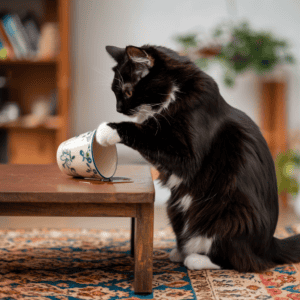 Many cat owners have seen cats batting objects off tables, counters, or shelves.
Many cat owners have seen cats batting objects off tables, counters, or shelves.
This behavior can be amusing and frustrating, especially when valuable items are involved.
Why They Do It:
Cats often knock things over as part of their hunting instincts.
In the wild, cats use their paws to test and manipulate prey, and they carry this instinct into the home.
For some cats, batting objects down can also be a form of play or curiosity, testing how objects move and make noise.
Additionally, many cats learn that knocking things over gets attention, turning it into a form of communication with their humans.
This combination of instinct and learned behavior makes knocking items off surfaces one of the classic “weird” cat quirks.
Quick Tip:
Keep valuable items out of reach to prevent accidents, and consider providing interactive toys that let your cat swat and play safely.
Read more on the full article of “Why Cats Love to Knock Things Over – The Truth Behind This Mischievous Act”
2. Staring at Nothing
 Cats often stare intently into empty spaces or blank walls, leaving us wondering what has caught their attention.
Cats often stare intently into empty spaces or blank walls, leaving us wondering what has caught their attention.
Why They Do It:
This behavior is typically rooted in cats’ acute senses.
Cats can detect sounds, scents, and movements beyond human perception, so what looks like “nothing” to us may be entirely engaging to them.
They may hear distant sounds like a bird outside or sense subtle vibrations.
Alternatively, this staring can also be a part of their resting behavior, a moment of quiet observation as they relax.
While it may seem eerie, it’s usually a sign of their heightened awareness.
Quick Tip:
Unless the staring is paired with signs of agitation, such as vocalizing or pacing, it’s usually harmless and doesn’t require intervention.
For more on this behavior, read our in-depth article “Fascinating Yet Creepy: Why Cats Stare at Empty Spaces?”
3. Zoomies (Running Around Wildly)
Cats sometimes experience sudden bursts of energy, where they dash around the house at top speed, leaping over furniture and making sharp turns as if on an invisible track.
Why They Do It:
Zoomies are a natural behavior that allows cats to release pent-up energy and simulate the hunting activity they would experience in the wild.
Indoor cats don’t always have ample opportunity for physical exercise, so they may need to burn off extra energy in short, intense bursts.
This behavior is most common in the early morning or evening, reflecting their natural activity peaks as crepuscular hunters.
While it can be startling, zoomies are perfectly normal and typically a sign of a healthy, active cat.
Quick Tip:
Engage your cat in regular play sessions, especially in the evening, to help them use their energy before bedtime. This can also help reduce nighttime zoomies.
Learn more about this behavior and how to manage it in this article ” Cat Zoomies Explained: Why Do Cats Suddenly Turn Into Cheetahs?”
4. Head-Butting (Bunting)
 Head-butting, or “bunting,” occurs when a cat gently presses or rubs its head against you, other cats, or even objects.
Head-butting, or “bunting,” occurs when a cat gently presses or rubs its head against you, other cats, or even objects.
This behavior is often accompanied by purring or rubbing their cheeks on surfaces.
Why They Do It:
Bunting serves multiple purposes for cats. It’s a form of social bonding and is often a sign of affection.
Cats have scent glands on their heads, so when they bunt, they’re marking you or their environment with their scent, which signals that you’re part of their safe territory.
Bunting can also be a form of social bonding among cats in multi-cat households.
For humans, receiving a head-butt is generally a high compliment, as it signifies that your cat sees you as part of their trusted circle.
Quick Tip:
If your cat is in a “bunting mood,” gently petting them can help reinforce the positive connection and make them feel even more secure.
Discover the deeper reasons behind bunting in this article “Why Do Cats Headbutt? – Decoding the Irresistible Charm
5. Kneading (Making Biscuits)
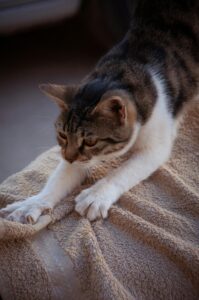 When cats knead, they press their paws rhythmically into a soft surface, like a blanket, a pillow, or even their owner’s lap.
When cats knead, they press their paws rhythmically into a soft surface, like a blanket, a pillow, or even their owner’s lap.
This behavior is often described as “making biscuits” because it resembles kneading dough.
Why They Do It:
Kneading originates from kittenhood, where kittens instinctively knead their mother’s belly to stimulate milk flow.
Many cats continue this comforting action into adulthood while purring to self-soothe or show contentment.
Kneading can also mark objects with the scent from glands on their paws, subtly claiming ownership of their environment.
For humans, a cat’s kneading on your lap is usually a sign of trust and affection, as they feel safe enough to engage in this vulnerable behavior.
Quick Tip:
If your cat’s kneading involves claws, consider placing a soft blanket over your lap to make it more comfortable for both of you.
Find out more about this comforting behavior in “Cat ‘Making Biscuits’: The Quirky Reasons Behind Your Cat’s Kneading Habit.”
6. Trying to Cover Up Their Food
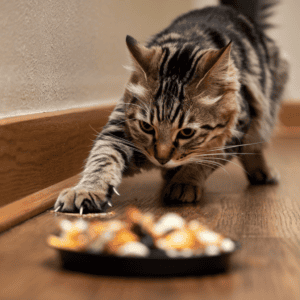 Some cats have a curious habit of trying to “bury” their food, scratching around the bowl or pushing objects over it as if trying to hide it from view.
Some cats have a curious habit of trying to “bury” their food, scratching around the bowl or pushing objects over it as if trying to hide it from view.
Why They Do It:
This behavior is linked to a cat’s natural survival instincts.
In the wild, cats sometimes cover leftover food to prevent attracting predators or to save it for later.
While domestic cats don’t need to worry about predators or leftovers, the instinct may still kick in.
Some cats may also find the smell of certain foods overwhelming and attempt to cover it as a form of scent control.
Quick Tip:
If your cat consistently tries to cover their food, consider feeding them smaller portions or using a shallow dish to see if it reduces the behavior.
Learn more about this instinct in this article “8 Hidden Reasons Why Your Cat Covers Their Food (Some May Surprise You!)”
7. Presenting the Elevated Butt
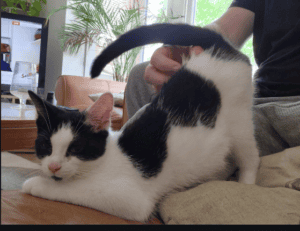 When petting a cat, you might notice it raises its rear end, arches its back, and points its tail upward.
When petting a cat, you might notice it raises its rear end, arches its back, and points its tail upward.
Why They Do It:
This is a sign of trust and affection.
Cats have scent glands near their tails, and by raising their rear, they’re presenting an area used for social bonding among cats.
It’s their way of saying they’re comfortable around you and inviting further interaction.
Additionally, mother cats groom this area on kittens, so the behavior may also be reminiscent of nurturing.
Quick Tip:
Respect this invitation by continuing to pet your cat gently; it’s one of the most evident signs that they feel safe and bonded with you.
Read more about this adorable behavior in this article “7 Secret Reasons Why Cats Lift Their Bum When Petted – And It Will Melt Your Heart!”
8. Chewing on Plastics & Other Unusual Objects
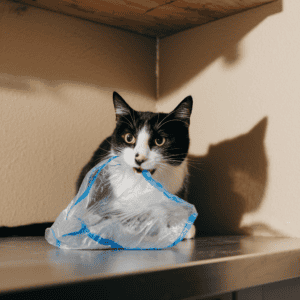 Many cats are fascinated with chewing on odd items like plastic bags, rubber bands, or other non-food items, which can seem puzzling to owners and even a bit concerning.
Many cats are fascinated with chewing on odd items like plastic bags, rubber bands, or other non-food items, which can seem puzzling to owners and even a bit concerning.
Why They Do It:
Chewing on plastic or similar items can stem from different motivations.
For some cats, the plastic texture is appealing, satisfying their curiosity and oral needs. Others may be attracted to the scents left on plastic bags, as certain chemicals or food residues may trigger their interest.
In some cases, however, this behavior might indicate boredom or a condition called pica—a craving to eat non-food objects—resulting from nutritional deficiencies, anxiety, or stress.
If your cat regularly chews on unusual items, it’s essential to monitor them to ensure they don’t accidentally swallow anything harmful.
Quick Tip:
Keep plastic bags and other tempting objects out of reach to discourage this habit. Providing appropriate chew toys or cat-safe plants like cat grass may also help divert their interest.
Read the full article on the reasons and solutions for this behavior : “Why Cats Chew on Plastic: Unraveling This Bizarre Behavior”
9. Bringing “Gifts” to Owners
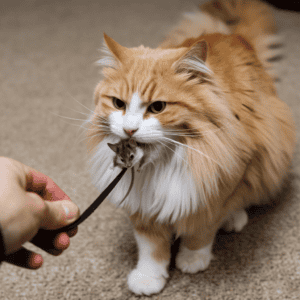 What It Is: Some cats bring “gifts” to their owners, often in the form of toys, socks, or, less pleasantly, small animals like mice or insects.
What It Is: Some cats bring “gifts” to their owners, often in the form of toys, socks, or, less pleasantly, small animals like mice or insects.
Why They Do It:
This behavior is often rooted in a cat’s instinct as a hunter and provider.
In the wild, cats bring prey back to share with their family or to teach their young how to hunt.
When they bring items to their human family members, it may be their way of showing affection, sharing a “catch,” or trying to teach us a skill. It’s a social gesture that signifies your cat considers you a part of their group, even if the “gift” may not be something you’d prefer to receive!
Quick Tip:
To prevent undesirable gifts, engage your cat with interactive toys to channel their hunting instincts and praise them when they bring toys rather than unwanted “presents.”
Learn more about this adorable behavior in our article “Why Do Cats Bring You ‘Gifts’? Unraveling the Mystery of Cat “Gift-Giving” Behavior”
10. Sleeping in Unusual Positions and Places
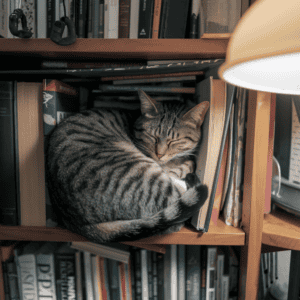 Cats often choose strange locations to sleep, like tight spaces, the top of a bookshelf, or even inside boxes and bags.
Cats often choose strange locations to sleep, like tight spaces, the top of a bookshelf, or even inside boxes and bags.
They also adopt odd sleeping positions, such as curled tightly into a ball or sprawled out on their backs.
Why They Do It:
These sleeping habits often serve a purpose. Cats choose enclosed spaces like boxes for the security and warmth they provide.
Unusual sleeping positions may result from comfort or temperature regulation. For example, a cat curled up tightly might be trying to stay warm, while a cat lying belly-up may feel completely relaxed and safe.
These choices reflect their natural instincts for security and comfort.
Quick Tip:
If your cat loves boxes, leave a few safe ones around to satisfy their need for a cozy hiding spot.
Want to know more about this weird cat sleeping behavior? Check out this article on “The Art of Cat Napping: Why Cats Sleep in the Strangest Places in the Funniest Positions” for more insights.
11. Fondness for Boxes and Tight Spaces
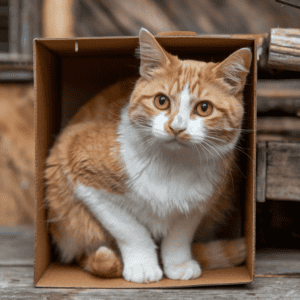 Cats seem irresistibly drawn to boxes, small nooks, and even laundry baskets, often choosing these spots over more open or apparent places to relax.
Cats seem irresistibly drawn to boxes, small nooks, and even laundry baskets, often choosing these spots over more open or apparent places to relax.
Why They Do It:
This behavior is linked to a cat’s natural desire for warmth, security, and a good vantage point for observing their environment.
Small, enclosed spaces make cats feel secure and protected, allowing them to hide from potential threats or relax without feeling exposed.
Boxes, in particular, offer the ideal combination of insulation, privacy, and visibility.
Quick Tip:
If your cat loves boxes, consider keeping one or two around as safe spaces, especially during times of stress or changes in the household.
Read more in “Cats and Boxes: Unlocking the Secrets Behind This Irresistible Obsession”
12. Chattering and Chirping
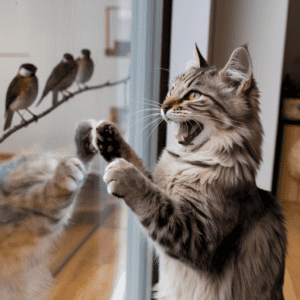 Many cat owners have noticed their cats making a distinctive “chattering” or “chirping” sound, especially when they’re watching birds, small animals, or sometimes even insects.
Many cat owners have noticed their cats making a distinctive “chattering” or “chirping” sound, especially when they’re watching birds, small animals, or sometimes even insects.
Quick, small jaw movements and intense focus usually accompany this sound.
Why They Do It:
Chattering and chirping are believed to be rooted in a cat’s hunting instincts.
Cats may feel excitement and frustration when observing prey that’s out of reach, causing this vocalization.
Some experts believe that the sound mimics the noise cats might make during a killing bite, a motion used to subdue small prey by clamping down with their teeth. Others think it’s a way for cats to express the thrill of the “hunt” without the ability to pounce.
Some cat owners interpret it as their cat “talking” to the birds, as it often looks like an attempt at communication.
Quick Tip:
Chattering is harmless and usually just a sign of your cat’s keen instincts. If your cat frequently observes wildlife from a window, consider adding enrichment, like a perch or bird feeder outside, to keep them entertained and engaged.
Learn more about the reasons behind this vocalization in the article “The Secrets Behind Your Cat’s Bird-Watching Chirps and Chatters”
13. Licking the Floor
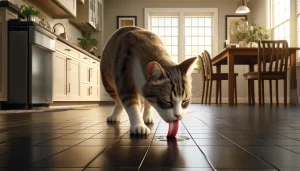 Some cats develop a habit of licking floors, whether it’s tiles, hardwood, or even carpets.
Some cats develop a habit of licking floors, whether it’s tiles, hardwood, or even carpets.
This behavior can seem odd, especially when there doesn’t appear to be anything edible on the surface.
Why They Do It:
Cats might lick floors for a variety of reasons. Often, they’re attracted to lingering scents or residue from food spills or cleaning products.
In some cases, it may be a form of exploration, as cats use their tongues to gather sensory information.
However, excessive floor licking could also point to stress, boredom, or even medical conditions like pica—a compulsion to eat non-food objects, which may stem from nutritional deficiencies or underlying health issues.
Quick Tip:
If your cat’s floor-licking seems obsessive or unusual, observe the behavior for patterns and consult a veterinarian to rule out medical concerns.
Keeping floors clean and free of tempting residues might also help reduce this habit.
Find out more about why cats engage in unusual licking behaviors in our article “Why is my cat licking the floor? Bizarre or Normal?
Ending Thoughts
Cats’ quirky behaviors are more than just entertaining—they’re windows into how our feline friends perceive and interact with the world.
By understanding the roots of these actions, we can appreciate their complexity and deepen our bond with them.
Whether your cat is zooming, bunting, or simply staring into space, each behavior is part of what makes them so unique.
Please share this article if you think it deserves. Have a nice day!
